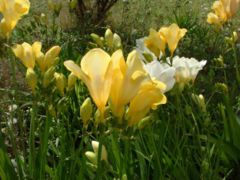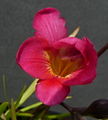Freesia: Difference between revisions
Sunset and AHS info |
|||
| Line 77: | Line 77: | ||
==Gallery== | ==Gallery== | ||
<gallery> | <gallery> | ||
Image: | Image:Hot pink-150.jpg | ||
Image: | Image:Freesia buds-3304.jpg | ||
Image: | Image:Freesia-5388.jpg | ||
Image:Bunch of cut freesia-462.jpg | |||
Image:Freesias 4-7989.jpg | |||
Image:Klein aber fein, piccola ma bella-2503.jpg | |||
Image:Freesia with buds-1092.jpg | |||
Image:Soft white, sanftes weiss, bianco delicato-5767.jpg | |||
Image:Freesia in the Rain-3475.jpg | |||
</gallery> | </gallery> | ||
Revision as of 21:24, 3 February 2009
Freesia {{{latin_name}}}
|
Freesia
| ||||||||||||||||||||||||||||||||||||||||
|---|---|---|---|---|---|---|---|---|---|---|---|---|---|---|---|---|---|---|---|---|---|---|---|---|---|---|---|---|---|---|---|---|---|---|---|---|---|---|---|---|---|

|
|
| |||||||||||||||||||||||||||||||||||||||
| |||||||||||||||||||||||||||||||||||||||||
Flowers give of a rich perfume. White or yellow blooms tend to have strongest perfume. Row of 2 inch tubular flowers appear on stems about the same height as leaves. Flowers may be single or double, white, yellow, pink, red, orange, purple, lavender, blue or various combination's of these colors.
Cultivation
| Freesia calendar? | ||
|---|---|---|
| January: | flowering** | |
| February: | flowering** | |
| March: | flowering** | |
| April: | plant* | |
| May: | ||
| June: | ||
| July: | plant** | |
| August: | plant**, flowering* | |
| September: | flowering* | |
| October: | flowering* | |
| November: | ||
| December: | ||
| Notes: *outdoors, **indoors | ||
In mild climates, plant 2-3in (508cm) deep and apart (pointed end up) in autumn for spring flowering, or in the spring for summer flowering. After flowering, the leaves and stems will dry up, and then sprout from the corms again the next fall.
In cold climates, plant 2in deep indoors in a pot, and 2in apart. Keep in sunny window, with night temperatures as cool as you can. Use a soil-based potting soil with added grit.
Propagation
Freesia will self-sow if dead flower stems are left alone, though seedling may revert to simple white or cream flowers. Corms will quickly multiply underground. If you purchase or collect seeds, they can be planted in July-August and should sprout easily, possibly blooming their first spring.
Pests and diseases
Freesias are used as food plants by the larvae of some Lepidoptera species including Large Yellow Underwing.
Species
There are 14-16 species of Freesia, all native to Africa. Of the 14 species, 12 are native to Cape Province, South Africa, the remaining two to tropical Africa, one species extending north of the equator to Sudan. F. refracta is the most commonly grown species, which during the 19th century got crossed with F. leichtlinii. Many cultivars arose from those species, as well as pink and yellow flowering F. corymbosa.
- Freesia alba
- Freesia andersoniae
- Freesia caryophyllacea
- Freesia corymbosa
- Freesia fergusoniae
- Freesia fucata
- Freesia grandiflora
- Freesia iwuzhere
- Freesia laxa (syn. Anomatheca laxa, Lapeirousia laxa)
- Freesia leichtlinii
- Freesia occidentalis
- Freesia refracta
- Freesia sparrmannii
- Freesia speciosa
- Freesia verrucosa
- Freesia viridis (syn. Anomatheca viridis)
Gallery
References
- w:Freesia. Some of the material on this page may be from Wikipedia, under the Creative Commons license.
- Freesia QR Code (Size 50, 100, 200, 500)
- American Horticultural Society: A-Z Encyclopedia of Garden Plants, by Christopher Brickell, Judith D. Zuk. 1996. ISBN 0789419432
- Sunset National Garden Book. Sunset Books, Inc., 1997. ISBN 0376038608








